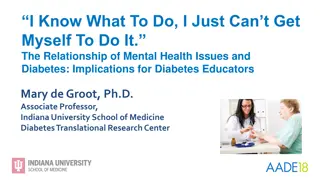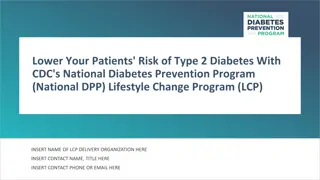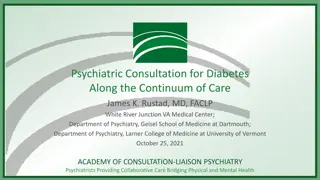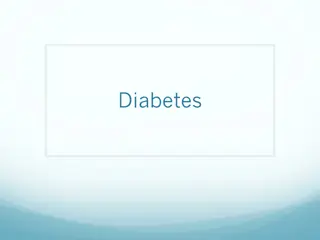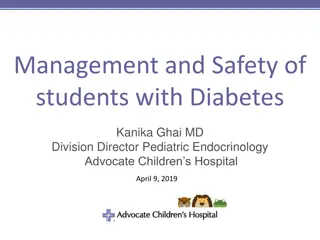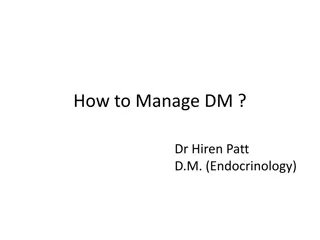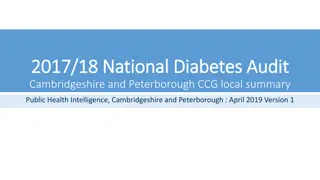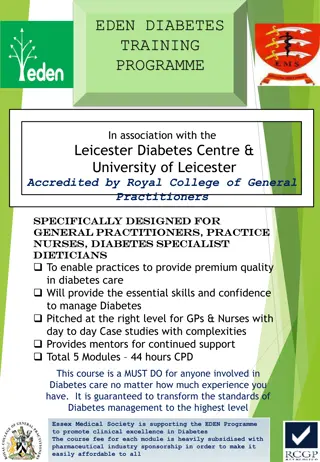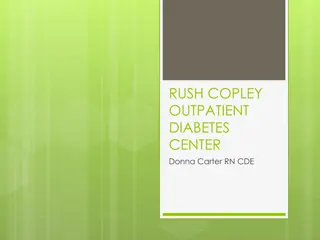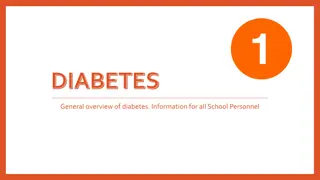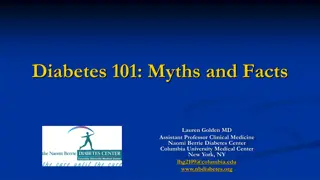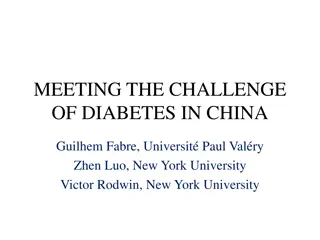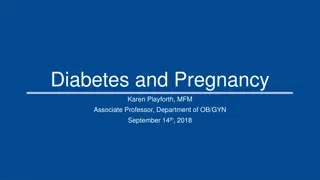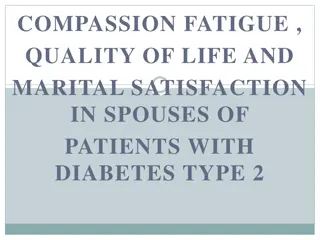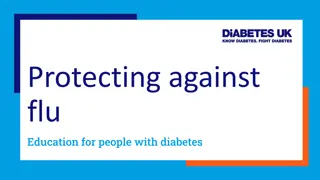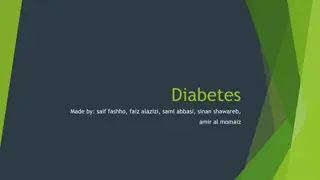Improving Diabetes Measure Rates
AmeriHealth Caritas Louisiana is focusing on improving diabetes measure rates through various initiatives such as combined diet and physical activity programs, counseling, and engaging community health workers. They aim to reduce disparities and enhance health outcomes for members. By comparing Louisiana to national data and setting annual goals, they are working towards addressing barriers and challenges to diabetes management.
Download Presentation

Please find below an Image/Link to download the presentation.
The content on the website is provided AS IS for your information and personal use only. It may not be sold, licensed, or shared on other websites without obtaining consent from the author.If you encounter any issues during the download, it is possible that the publisher has removed the file from their server.
You are allowed to download the files provided on this website for personal or commercial use, subject to the condition that they are used lawfully. All files are the property of their respective owners.
The content on the website is provided AS IS for your information and personal use only. It may not be sold, licensed, or shared on other websites without obtaining consent from the author.
E N D
Presentation Transcript
Improving Diabetes Measure Rates of AmeriHealth Caritas Louisiana Members Theresa Cao Louisiana State University Health Sciences Center New Orleans, LA School of Medicine, Class of 2024 AmeriHealth Caritas Louisiana Medical Intern August 23, 2023
DIABETES Combined diet and physical activity programs Counseling, coaching, individualized guidance Engaging community health workers for diabetes prevention and management Mobile phone apps for self-management (Type 2 Diabetes) Team-Based Care
Comparing Louisiana to National Data National Louisiana % of Total Diagnosed Aged 18+ Years (2021) 8.5% 12.4% Number of Total Diagnosed Aged 18+ (2021) 24 million 487,000 Estimated Economic Costs (2017) $327 billion $5.7 billion
Improve diabetes measure rates at least 2% annually Expand efforts on social determinants of health and diabetes by working to identify, address, and monitor health disparities and close care gaps for improved health outcomes Healthy Louisiana Medicaid Program Goals Reinforce the importance of annual visits and routine screenings Decrease avoidable urgent care visits, emergency room visits and hospitalizations among diabetic population
Past and Present Performance Rates MY 2020 MY 2021 MY 2022 MY 21-22 Stat Sig. Measure/Data Element Change in % points Rate Rate Rate Y/N (HBD) HbA1c poor control (>9.0%)* Inverse Measure, Less is Better 48.66% 43.80% 39.66% +4.14% Y (HBD) HbA1c control (<8.0%) 41.85% 46.96% 53.04% +6.08% Y Previous Year Rate (June) Interim Results Measure Comparison Goal (HBD) HbA1c poor control (>9.0%)* Inverse Measure, Less is Better 2022 Plan 2% annual decrease goal, 37.66% (Goal Not Met) 73.90% 68.04% 2022 Plan 2% annual increase goal, 55.04% (Goal Not Met) (HBD) HbA1c control (<8.0%) 21.96% 27.95%
Identified Barriers and Challenges Members Health literacy: knowledge about importance of routine visits Affordability: cannot afford weight loss program Access to resources: living in food desert areas, reliable transportation, reliable phone lines for appointment reminders, hesitancy to doctors visits due to COVID-19 Providers Availability: appointment availability, PCPs in network in area, continuity of care with established PCP Billing issues: unaware of measure incentives Provider practice variation with recommended guidelines Managed Care Organization Internal resources Lengthy internal approval process for member materials
Current Strategies and Interventions Members Education: social media campaigns, MPulse texting, Population Health Disease Management mailing Telehealth visits, home visits, mobile units Care Card member incentive, Make Every Calorie Count weight management program Providers Education: HEDIS coding guidelines and newsletters, Provider Report Card After hours incentive through Wellness Days Increase urgent care network Managed Care Organization Increase collaborations with communities
Data Analysis Total population: Data obtained from 10,469 diagnosed diabetics aged 18 75 years old ACLA members during year 2022 Adequate Control HbA1c Population: Members with most recent HbA1c level < 8.0% Poor Control HbA1c Population: Members with most recent HbA1c level > 9.0% or identified as 0, indicating HbA1c test is missing or was not done during 2022 < 8.0% : 1850 > 9.0%: 458 Missing or not tested HbA1c: 7943 Included other data corresponding to: LDH Region of Residence Gender Age Race Language Spoken
Louisiana Department of Health Regional Map
Proportion of Members in Region with Adequate Control Proportion of Members in Region with Poor Control Demographic Characteristic Region Ranking Count % within each region Count % within each region Region Region 1 442 22% 1541 78% Region 2 395 28% 1010 72% 3rd Region 3 93 11% 718 89% Region 4 191 17% 948 83% 1st Region 5 33 8% 394 92% Region 6 154 21% 574 79% 2nd Region 7 126 10% 1158 90% 4th Region 8 126 15% 736 85% Region 9 206 19% 862 81% Unknown 79 17% 387 83% Total 1850 8401
Gender Distribution Age Groups Distribution 9000 4000 7850 8000 3614 3500 7000 3000 6000 2515 2500 5000 4251 2000 4000 1646 1610 1500 3000 1000 866 2000 500 1000 0 0 <30 30-39 40-49 50-60 >60 Male Female
Proportion of Members in Group with Adequate Control Proportion of Members in Group with Poor Control Demographic Characteristic Ranking Count % within each group Count % within each group Gender Male 605 17% 3646 83% Female 1245 19% 6605 81% Age Groups 1st 12% 88% < 30 108 714 2nd 17% 83% 30 - 39 270 1268 3rd 18% 82% 40 - 49 451 1931 19% 81% 50 - 60 684 2771 20% 80% > 60 337 1259 Total 1850 8401
Proportion of Members in Group with Adequate Control Proportion of Members in Group with Poor Control Demographic Characteristic Ranking Count % within each group Count % within each group Race 2nd White 656 18% 2953 82% 2nd Black / African American 1010 18% 4665 82% Asian or Pacific Islander 32 25% 97 75% 1st American Indian / Alaskan Native 14 15% 82 85% Unknown 134 19% 568 81% Total 1846 8365 Language Spoken English 1799 18% 8244 82% Spanish 31 20% 127 80% Total 1830 8371 *Due to total groups of n < 20, subgroups of race (such as Hispanic, Native Hawaiian, Asian Indian, Guamania or Chamorro, Samoan) and language spoken (Vietnamese, French, Cambodian, Portuguese, Unknown) were no included in chart analysis
Data Summary Region of Residence Region 5, 7, 3, 8 (Lake Charles, Shreveport, Houma, Monroe) had the most % of poorly controlled members Race American Indian / Alaskan Native had ranked 1st in proportion of poorly controlled than all other race groups, with White and Black / African American ranking 2nd Gender Men had more % of poorly controlled members than women Language Spoken English speaking group had higher poor control than Spanish Age Trend of younger age groups being more poorly controlled than older age groups; as age increased, proportion of adequate control also increased
Recommendations Group-specific Emphasizing current interventions specifically in regions of Lake Charles, Shreveport, Houma, and Monroe Providing more infographics appealing to younger audiences General Providing incentive to provider and members of yearly clinic visits and HbA1c testing Increasing awareness of established ACLA programs and incentives to both members and providers Providing ACLA providers with monthly reports of poorly controlled and non-compliant diabetic members Providing more flyers and infographics to all diabetic members at every office visit and in community settings Increasing texting alerts, reminders and diabetes educational facts to younger members Increasing program engagement especially in American Indian, Alaskan Native, and African American communities Encouraging provider discussions on health equity, implicit and explicit bias with non-White groups
Acknowledgments Renee Wells Dr. Gregory Randolph Dana Smith Shea Good Agnes Robinson Lekitha Gregory Carrie Blades Rhonda Baird Thank you!
References Centers for Disease Control and Prevention. National Diabetes Statistics Report website. https://www.cdc.gov/diabetes/data/statistics-report/appendix.html. Centers for Disease Control and Prevention. Diabetes State Burden Toolkit website. https://nccd.cdc.gov/Toolkit/DiabetesBurden/Prevalence Centers for Disease Control and Prevention. United States Diabetes Surveillance System. Division of Diabetes Translation. https://gis.cdc.gov/grasp/diabetes/diabetesatlas-surveillance.html American Diabetes Association. The Burden of Diabetes in Louisiana. https://diabetes.org/sites/default/files/2021-10/ADV_2021_State_Fact_sheets_Louisiana.pdf The Community Guide. CPSTF Findings for Diabetes. Interventions to Prevent or Manage Diabetes. https://www.thecommunityguide.org/pages/task-force-findings-diabetes.html
Diagnosed Diabetes, Total, Adults Aged 18+ Years, Age-Adjusted Percentage, U.S. States, 2021 Percentage ( Natural Breaks ) 4.3 - 6.5 6.6 - 7.7 7.8 - 8.9 9 - 10.8 10.9 - 16.6 No Data Suppressed USDSS Source: USDSS Disclaimer: This is a user-generated report. The findings and conclusions are those of the user and do not necessarily represent the views of the CDC. National Center for Chronic Disease Prevention and Health Promotion Division of Diabetes Translation
Diagnosed Diabetes, Total, Adults Aged 20+ Years, Age-Adjusted Percentage, Louisiana, 2020 Percentage ( Natural Breaks ) 5.8 - 8 8.1 - 9.1 9.2 - 10 10.1 - 11.2 11.3 - 16.1 No Data Suppressed USDSS Source: USDSS Disclaimer: This is a user-generated report. The findings and conclusions are those of the user and do not necessarily represent the views of the CDC. National Center for Chronic Disease Prevention and Health Promotion Division of Diabetes Translation


